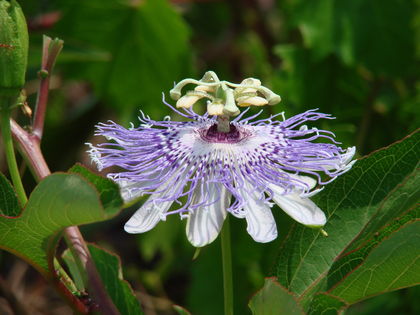Passionflower

Definition
Passionflower ( Passiflora incarnata ) is a vine whose leaves and flowers are widely used in Europe to make a herbal remedy for anxiety and insomnia . The plant, which is native to the tropical regions of North America, was first used by the Aztecs of Mexico as a folk remedy for these conditions. Passionflower is also known as maypop, apricot vine, passion vine, and granadilla. It grows as much as 30 ft (10 m) tall, with a thick, woody stem.
Passionflower received its name from the sixteenth-century conquistadors who claimed Mexico for the Spanish Empire. The priests and soldiers who accompanied Hernando Cortez thought that the whitish-purple flowers of the vine symbolized certain features of the passion of Christ. The corona in the center of the flower reminded them of Christ's crown of thorns, the five stamens of the number of Christ's wounds, and the tendrils of the whips that were used to scourge Christ.
Purpose
Passionflower is still used as a sedative and anxiolytic, although far more frequently in Great Britain and Europe than in the United States. In Britain, passionflower is the single most common ingredient in herbal sedatives, and the German Commission E approved it for use as a tranquilizer. It is also used in homeopathic remedies. In addition to its long-standing uses as a remedy for anxiety and insomnia, passionflower has also been recommended for the treatment of gastrointestinal disorders related to anxiety; asthma; tachycardia (an abnormally rapid heartbeat); menstrual cramps; seizures ; attention-deficit/hyperactivity disorder ; and hysteria. A topical preparation made from passionflower has been used to treat hemorrhoids.
The parts of the plant that grow above the ground are gathered to make passionflower preparations. They may be used either fresh or dried. The most common sources of the passionflower that is used today are India, the West Indies, and the southern United States, even though the vine can also be grown in Mexico and Latin America.
Description
Passionflower preparations may be made from the flowers, leaves, or shoots of the plant. After the first fruits of the plant have matured, younger shoots growing 12.7–17.8 cm. above the ground are harvested and air-dried. The plant material is then used to prepare infusions, teas, liquid extracts, and tinctures of passionflower. In Europe, passionflower is often combined with lemon balm or valerian to make a sedative tea. The standardized formula approved by the German Commission E contains 30% passionflower, 40% valerian root, and 30% lemon balm. Passionflower is also used to make a special sedative tea for children, which typically includes 30% passionflower, 30% lemon balm, 30% lavender flower, and 10% St. John's wort . Passionflower is sometimes combined with hawthorn to make a remedy for stomach cramps associated with gastritis.
Although passionflower has been shown in animal studies to have sedative and antispasmodic effects, researchers are not yet certain which compounds in the plant have these properties. Passionflower is known to contain flavonoids and a group of alkaloid compounds that include harman, harmine, harmaline, and harmalol. Some researchers have hypothesized that the medicinal effects of passionflower derive from a combination of these substances rather than from any of them in isolation. A recent Swiss study, however, appears to indicate that a flavonoid called chrysin may be the source of passionflower's anxiolytic properties.
Recommended dosage
As the German recipe indicates, passionflower is considered safe for children. Dosages for children should be calculated on the basis of the child's weight. Since most adult dosages of herbal remedies assume an average adult weight of 150 lb (70 kg), a child weighing 50 lb (23 kg) can be given 1/3 of the adult dose.
Recommended adult doses of passionflower are as follows:
- • Infusion: 2–5 g of dried herb, up to three times daily
- • Fluid extract (1:1 ratio in a solution of 25% alcohol):0.5–1.0 mL up to three times daily
- • Tincture (1:5 ratio in a solution of 45% alcohol):0.5–2.0 mL up to three times daily.
Precautions
Passionflower should not be used in doses higher than the recommended levels. Because it has a sedative effect, it should not be combined with alcoholic beverages or prescription sedatives. Passionflower should not be used by pregnant or lactating women, or for children under six months old.
Side effects
As of 2002, passionflower has not been reported to cause any significant side effects when taken at recommended dosage levels.
Interactions
The alkaloids found in passionflower, especially harman and harmaline, may increase the effects of a class of prescription antidepressants called monoamine oxidase inhibitors (MAOIs). These drugs are most often prescribed for depression, panic attacks, and eating disorders. Passionflower may also increase the effects of over-the-counter sedatives as well as prescription sedatives.
Resources
BOOKS
Pelletier, Kenneth R., MD. "Western Herbal Medicine: Nature's Green Pharmacy." Chapter 6 in The Best Alternative Medicine. New York: Simon and Schuster, 2000.
Tyler, Varro E. Herbs of Choice. New York: Pharmaceutical Products Press, 1994.
PERIODICALS
Capasso, A., and A. Pinto. "Experimental Investigations of the Synergistic-Sedative Effect of Passiflora and Kava." Acta Therapeutica 21 (1995): 127–140.
Soulimani, R., C. Younos, S. Jarmouni, and others. "Behavioural Effects of Passiflora incarnata L. and its Indole Alkaloid and Flavonoid Derivatives and Maltol in the Mouse." Journal of Ethnopharmacology 57 (1997): 11–20.
Zanoli, P., R. Avallone, and M. Baraldi. "Behavioral Characterisation of the Flavonoids Apigenin and Chrysin." Fitoterapia 71 (2000): S117–S123.
OTHER
American Botanical Council. PO Box 144345. Austin, TX 78714-4345. <www.herbalgram.org> .
Herb Research Foundation. 1007 Pearl Street. Suite 200. Boulder, CO 80302. <www.herbs.org> .
Rebecca J. Frey, Ph.D.